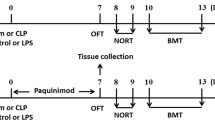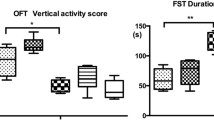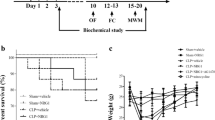Abstract
Sepsis-associated encephalopathy (SAE), which associates with neuronal apoptosis and cognitive disorders, is a common complication of systemic sepsis. However, the mechanism involving its modulation remains to be elucidated. Recent studies showed that histone deacetylases (HDACs) were implicated in neurodegeneration and cognitive functions. The current study was designed to investigate whether septic brain is epigenetically modulated by HDACs, using cecal ligation and peroration (CLP) rats and primary hippocampal neuronal cultures. We found that hippocampal acetylated histone 3 (AcH3), acetylated histone 4 (AcH4), cytoplasmic HDAC4 and Bcl-XL were inhibited in septic brain. Hippocampal Bax and nuclear HDAC4 expressions were enhanced in CLP rats. Administration of HDACs inhibitor, trichostatin A (TSA) or suberoylanilide hydroxamic acid (SAHA) rescued the changes of Bcl-XL and Bax in vivo, and decreased apoptotic cells in vitro. In addition, HDAC4 shRNA transfection significantly enhanced AcH3, AcH4 and Bcl-XL, but suppressed Bax. Neuronal apoptosis was also reduced by transfection of HDAC4 shRNA. Furthermore, CLP rats exhibited significant spatial learning and memory deficits, which could be ameliorated by application of TSA or SAHA without influence on locomotive activity. These results reveal that epigenetic modulation is involved in septic brain, and the inhibition of HDACs may serve as a potential therapeutic approach for SAE treatment.




Similar content being viewed by others
References
Iacobone E, Bailly-Salin J, Polito A, Friedman D, Stevens RD, Sharshar T (2009) Sepsis-associated encephalopathy and its differential diagnosis. Crit Care Med 37:S331–S336
Papadopoulos MC, Davies DC, Moss RF, Tighe D, Bennett ED (2000) Pathophysiology of septic encephalopathy: a review. Crit Care Med 28:3019–3024
d’Avila JC, Santiago AP, Amancio RT, Galina A, Oliveira MF, Bozza FA (2008) Sepsis induces brain mitochondrial dysfunction. Crit Care Med 36:1925–1932
Weberpals M, Hermes M, Hermann S, Kummer MP, Terwel D, Semmler A, Berger M, Schafers M, Heneka MT (2009) NOS2 gene deficiency protects from sepsis-induced long-term cognitive deficits. J Neurosci 29:14177–14184
Semmler A, Hermann S, Mormann F, Weberpals M, Paxian SA, Okulla T, Schafers M, Kummer MP, Klockgether T, Heneka MT (2008) Sepsis causes neuroinflammation and concomitant decrease of cerebral metabolism. J Neuroinflammation 5:38
Varga-Weisz PD, Becker PB (1998) Chromatin-remodeling factors: machines that regulate? Curr Opin Cell Biol 10:346–353
Yang XJ, Seto E (2007) HATs and HDACs: from structure, function and regulation to novel strategies for therapy and prevention. Oncogene 26:5310–5318
Jiang Y, Langley B, Lubin FD, Renthal W, Wood MA, Yasui DH, Kumar A, Nestler EJ, Akbarian S, Beckel-Mitchener AC (2008) Epigenetics in the nervous system. J Neurosci 28:11753–11759
Levenson JM, Sweatt JD (2005) Epigenetic mechanisms in memory formation. Nat Rev Neurosci 6:108–118
Fischer A, Sananbenesi F, Mungenast A, Tsai LH (2010) Targeting the correct HDAC(s) to treat cognitive disorders. Trends Pharmacol Sci 31:605–617
Chen B, Cepko CL (2009) HDAC4 regulates neuronal survival in normal and diseased retinas. Science 323:256–259
Li J, Chen J, Ricupero CL, Hart RP, Schwartz MS, Kusnecov A, Herrup K (2012) Nuclear accumulation of HDAC4 in ATM deficiency promotes neurodegeneration in ataxia telangiectasia. Nat Med 18:783–790
Kaech S, Banker G (2007) Culturing hippocampal neurons. Nat Protoc 1:2406–2415
Geng H, Harvey CT, Pittsenbarger J, Liu Q, Beer TM, Xue C, Qian DZ (2011) HDAC4 protein regulates HIF1alpha protein lysine acetylation and cancer cell response to hypoxia. J Biol Chem 286:38095–38102
Huang X, Venet F, Wang YL, Lepape A, Yuan Z, Chen Y, Swan R, Kherouf H, Monneret G, Chung CS, Ayala A (2009) PD-1 expression by macrophages plays a pathologic role in altering microbial clearance and the innate inflammatory response to sepsis. Proc Natl Acad Sci USA 106:6303–6308
Chuang DM, Leng Y, Marinova Z, Kim HJ, Chiu CT (2009) Multiple roles of HDAC inhibition in neurodegenerative conditions. Trends Neurosci 32:591–601
Polster BM, Fiskum G (2004) Mitochondrial mechanisms of neural cell apoptosis. J Neurochem 90:1281–1289
Raghupathi R, Strauss KI, Zhang C, Krajewski S, Reed JC, McIntosh TK (2003) Temporal alterations in cellular Bax: Bcl-2 ratio following traumatic brain injury in the rat. J Neurotrauma 20:421–435
Lubin FD, Roth TL, Sweatt JD (2008) Epigenetic regulation of BDNF gene transcription in the consolidation of fear memory. J Neurosci 28:10576–10586
Guan JS, Haggarty SJ, Giacometti E, Dannenberg JH, Joseph N, Gao J, Nieland TJ, Zhou Y, Wang X, Mazitschek R, Bradner JE, DePinho RA, Jaenisch R, Tsai LH (2009) HDAC2 negatively regulates memory formation and synaptic plasticity. Nature 459:55–60
Gaub P, Tedeschi A, Puttagunta R, Nguyen T, Schmandke A, Di Giovanni S (2010) HDAC inhibition promotes neuronal outgrowth and counteracts growth cone collapse through CBP/p300 and P/CAF-dependent p53 acetylation. Cell Death Differ 17:1392–1408
Author information
Authors and Affiliations
Corresponding author
Rights and permissions
About this article
Cite this article
Fang, J., Lian, Y., Xie, K. et al. Epigenetic modulation of neuronal apoptosis and cognitive functions in sepsis-associated encephalopathy. Neurol Sci 35, 283–288 (2014). https://doi.org/10.1007/s10072-013-1508-4
Received:
Accepted:
Published:
Issue Date:
DOI: https://doi.org/10.1007/s10072-013-1508-4




